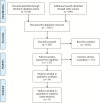N-of-1 Randomized Intervention Trials in Health Psychology: A Systematic Review and Methodology Critique
- PMID: 30124759
- PMCID: PMC6128372
- DOI: 10.1093/abm/kax026
N-of-1 Randomized Intervention Trials in Health Psychology: A Systematic Review and Methodology Critique
Abstract
Background: Single-patient, multiple cross-over designs (N-of-1 or single-case randomized clinical trials) with systematic data collection on treatment effects may be useful for increasing the precision of treatments in health psychology.
Purposes: To assess the quality of the methods and statistics, describe interventions and outcomes, and explore the heterogeneity of treatment effect of health psychology N-of-1 trials.
Methods: We conducted a systematic review of N-of-1 trials from electronic database inception through June 1, 2015. Potentially relevant articles were identified by searching the biomedical electronic databases Ovid, MEDLINE, EMBASE, all six databases in the Cochrane Library, CINAHL, and PsycINFO, and conference proceedings, dissertations, ongoing studies, Open Grey, and the New York Academy's Grey Literature Report. Studies were included if they had health behavior or psychological outcomes and the order of interventions was randomized. We abstracted study characteristics and analytic methods and used the Consolidated Standards of Reporting Trials extension for reporting N-of-1 trials as a quality checklist.
Results: Fifty-four N-of-1 trial publications composed of 1,193 participants were included. Less than half of these (36%) reported adequate information to calculate the heterogeneity of treatment effect. Nearly all (90%) provided some quantitative information to determine the superior treatment; 79% used an a priori statistical cutoff, 12% used a graph, and 10% used a combination.
Conclusions: N-of-1 randomized trials could be the next major advance in health psychology for precision therapeutics. However, they must be conducted with more methodologic and statistical rigor and must be transparently and fully reported.
Figures
References
-
- Guyatt G, Sackett D, Taylor DW, Chong J, Roberts R, Pugsley S. Determining optimal therapy—randomized trials in individual patients. N Engl J Med. 1986; 314(14): 889–892. - PubMed
-
- Sox HC, Greenfield S. Comparative effectiveness research: a report from the Institute of Medicine. Ann Intern Med. 2009; 151(3): 203–205. - PubMed
-
- Selby JV, Beal AC, Frank L. The Patient-Centered Outcomes Research Institute (PCORI) national priorities for research and initial research agenda. JAMA. 2012; 307(15): 1583–1584. - PubMed
Publication types
MeSH terms
Grants and funding
LinkOut - more resources
Full Text Sources
Other Literature Sources


